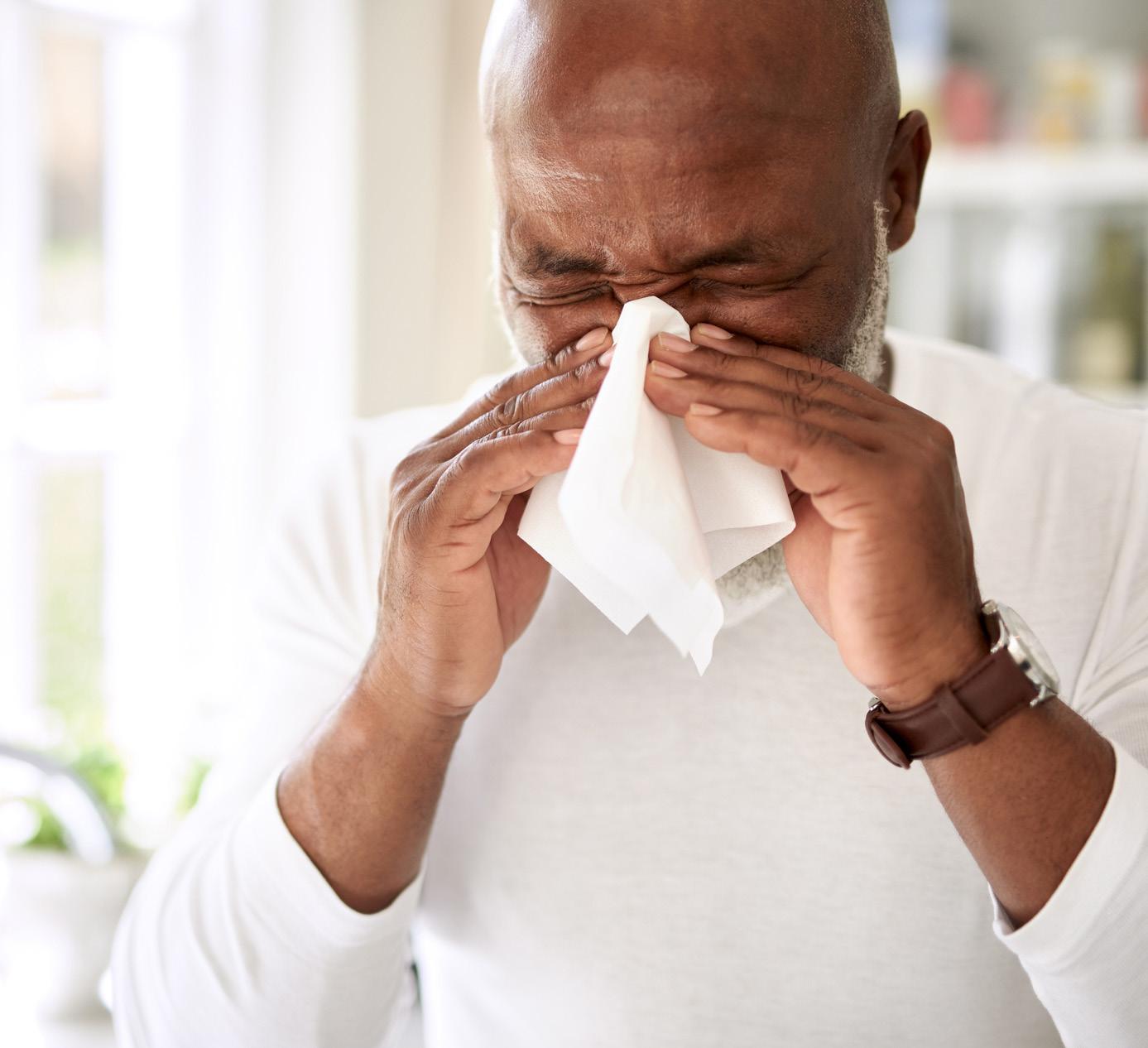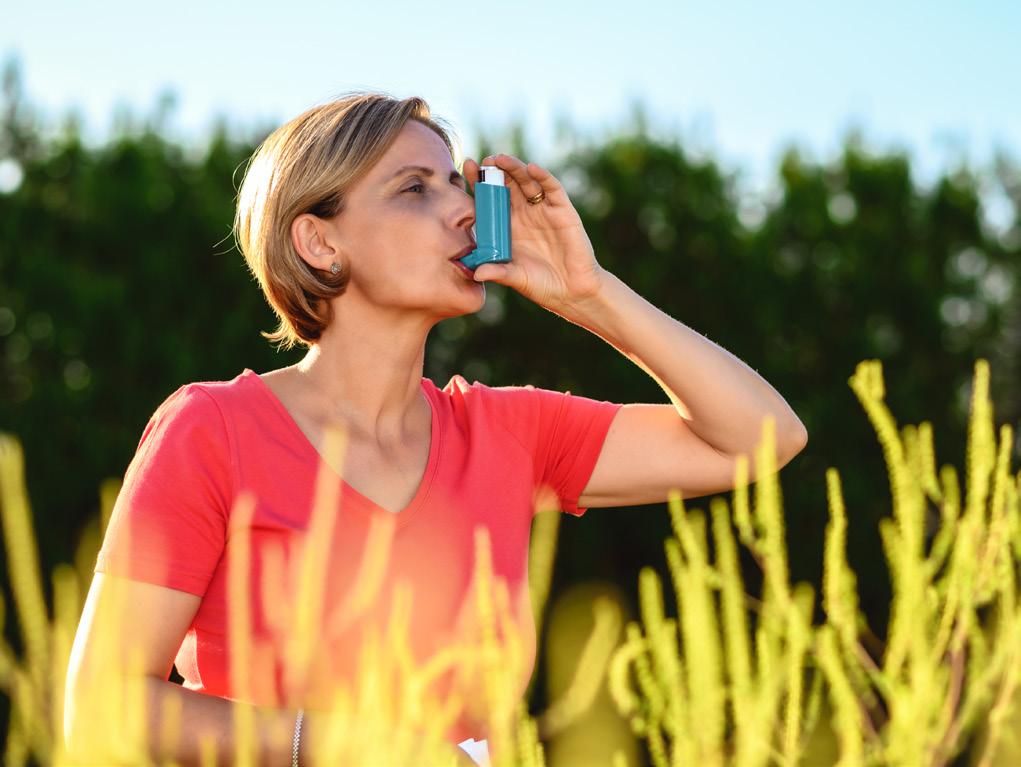

Health Your
In this issue of Your Health, we take a look at testicular cancer, which in the UK sees more than six men diagnosed each day. Now that spring has sprung, we have an in-depth piece on allergies and how to best protect yourself from allergy-related illness (or recover quickly). We end with an article on stress awareness – the different signs and symptoms to look out for in yourself and those around you (family, friends or colleagues). Sometimes, even the simple step of asking someone if they are okay can be very effective. We hope you enjoy this issue!
Testicular Cancer
In the UK, around 2,400 men are diagnosed with testicular cancer each year – that’s more than six each day. The risk profile for men is mainly between 18 to 45, peaking in the early 30s; it becomes less common as men get older.
You should check regularly for any changes to your testicles. The ideal time to check is just after a warm bath or shower: hold your scrotum in the palm of your hand and check each testicle by rolling it between the thumb and fingers.
It’s perfectly normal for testicles to be a different size and length; however, if you notice any changes such as swelling, lumps, hardening or pain, you should seek the advice of your GP as soon as possible. These symptoms can be a sign of infection, inflammation, fluid build-up (hydrocele) or damage, but you should get them checked to be safe.
Most testicular cancers can be cured if treated early so it is important to check regularly and don’t delay seeking GP advice.


“Around 2,400 men are diagnosed with testicular cancer each year in the UK”
The most common symptoms include: A painless swelling or lump in one of the testicles, or any change in shape or texture of the testicles. The swelling or lump can be about the size of a pea, but may be larger. Most lumps or swellings in the scrotum are not in the testicle and are not a sign of cancer, but they should never be ignored;
An increase in the firmness of a testicle; A difference in appearance between one testicle and the other;
A dull ache or sharp pain in your testicles or scrotum, which may come and go; A feeling of heaviness in your scrotum.


Allergy Awareness
What is an allergy?
An allergy is very simply our body’s reaction to a food or other substance – around one in four of us will have or have had some form of allergy, and it is more common in children.
Other than anaphylaxis, most allergic ‘reactions’ are mild and more of a nuisance than a real threat to health. The issue is the body perceiving the allergen to be a threat, and the allergic response is the body reacting to the threat.
Histamine is released by the body when it perceives a threat, which, in mild cases, may cause skin itching but can also narrow airways, cause tissue swelling or lower blood pressure.
Allergy/intolerance/sensitivity/anaphylaxis –aren’t they the same?
No, they are definitely not the same…
Allergy is an umbrella term used to describe the body reacting to an allergen –can be mild or more severe; Anaphylaxis – a severe and potentially life-threatening response to exposure to an allergen;
Intolerance – generally relating to digestion and the body producing unpleasant symptoms in response to a substance that doesn’t involve the immune system – responses may be diarrhoea, bloating or tummy pain;
Sensitivity – exaggerated effects of a substance on an individual, e.g. palpitations from caffeine or feeling dizzy from small amounts of alcohol.

Testing for allergies:
Testing is not always necessary to confirm an allergy, as it is often obvious. It can however be useful where it is unclear, particularly where the allergy is aggravating a condition such as asthma.
Testing can be:
Skin prick testing – a small amount of the substance in suspension is dropped onto the skin, which is pricked to allow the solution to penetrate. The skin is then carefully observed for a reaction;
IgE testing – where blood is tested for the presence of antibodies to specific allergens and is helpful where an allergy needs to be confirmed;
“Allergy is an umbrella term for the body reacting to an allergen”
Common allergy symptoms: Sneezing; A runny or blocked nose; Red, itchy, watery eyes; Wheezing and coughing; Tissue swelling; A red, itchy rash; Worsening of asthma or eczema symptoms.
Common causes of allergies:
Skin contact – nickel, plants, pollen, latex, household chemicals, hair dyes; Inhalation – pollen, mould spores, dust, animal dander; Ingestion – drugs, nuts, shellfish, fruits, dairy produce; Injection – drugs, insect stings, other venom.
History/examination – many simple and more common allergies can be assumed simply from the history and presentation; Patch testing – can be useful to confirm allergic contact dermatitis. Patches with substances are applied to skin and left in place for 48 hours and the reaction is observed; Elimination diet – involves simply eliminating a suspected food allergen completely from your diet to see if the symptoms improve, then reintroducing it gradually to see if they resume; Challenge tests – these can be helpful where it is important to confirm an allergy but they need to be carried out in a hospital setting.
Health Your
HAYFEVER – A REACTION TO POLLEN (EYES, NOSE, MOUTH, THROAT)
Hayfever (seasonal rhinitis) is a very common allergy. The body makes antibodies (IgE in reaction to grass or tree pollen); its incidence has trebled in the last 20 years. Some are affected seasonally, but others can be year round (perennial allergic rhinitis).
In the UK, grass pollen is highest from May to July and tree pollen from February to June. Perennial sufferers are often allergic to house dust mites and mould spores or pets, too. It is often seen as a trivial/nuisance issue – but can impact the performance of people and can be a miserable experience when impacting on sleep. It can also trigger dangerous exacerbations of asthma.
Treatments either reduce the histamine that is released (antihistamines) or the inflammation (such as nasal steroids). There are prescription-only combined treatments for moderate to severe cases and occasional nasal decongestion sprays can be helpful. On rare occasions, short courses of steroid tablets are considered. Immunotherapy/desensitisation is considered for treatment-resistant or severe cases – but is only administered under specialist supervision.

Ways to help
Avoid the trigger whenever practical - monitor the pollen reports and be aware of early mornings and evenings when it is usually highest. Avoid open windows when the pollen count is high.
Choose coastal rather than rural trips where possible if you struggle. On high pollen count days – shower, wash your hair and change clothes when returning indoors.
“In the UK, grass pollen is highest from May to July and tree pollen February to June”
Use sunglasses to protect the eyes outdoors and wide-brimmed hats. Delegate garden tasks where possible (and where not possible – consider sunglasses and RPE). Dry washing indoors. Set the car air conditioning to ‘recirculate’ and ensure there is a pollen filter included. Nasal balms and washes can be helpful to reduce particles and flush them out.

ALLERGIC ASTHMA
Inflammation of the airways – triggered by pollen, dust mites or animal dander. Many of those with allergic asthma will also have other allergy issues with eczema/ general allergy and/or hayfever.
Prevention is key – and all those with asthma should have a written asthma action plan.
Breathing difficulties that do not respond quickly to inhalers are always a medical emergency (also where no treatment available).

Health Your
ATOPIC ECZEMA (DERMATITIS)
This can be seen by dry, cracked, itchy, painful skin lesions. It can be anywhere – but more commonly elbows, backs of knees, hands and face or scalp. Children may grow out of it. It is much more common in conjunction with other atopy (such as hay fever) or strong family history.
Flare-ups can relate to detergents/ creams/weather/soaps. Treatment is initially emollients and steroid preparations as and when necessary – and for children – itch avoidance.
Allergy tests can be helpful to eliminate/ identify food allergies.
ANAPHYLAXIS
Anaphylaxis is a serious and lifethreatening condition.
Symptoms :
Feeling lightheaded or faint; Breathing difficulties such as fast, shallow breathing and tightness around the throat;
Wheezing; Fast heartbeat; Clammy skin; Red patchy rash/hives; Facial swelling; Confusion and anxiety; Collapsing or losing consciousness; Stopping breathing.


Awareness
Allergic signs and symptoms
Adrenaline Action
Allergy UK Helpline 01322 619898
www.allergyuk.org
ALLERGY AWARENESS
Causes and physiology: any allergen that can cause an allergic reaction can be a cause – but the most common allergens are: nuts/bee or wasp stings/shellfish/ drugs (mainly antibiotics or non-steroidal anti-inflammatory drugs)/latex.
The body recognises the trigger and has a rapid and overwhelming but disproportionate response to the perceived threat – releasing large quantities of chemicals into the bloodstream that forces the body into shock, dropping the blood pressure and restricting breathing.
999 and adrenaline: The casualty needs a lifesaving adrenaline injection – they may need help with this if there is incapacity. Call 999 and say you think it is anaphylaxis. Try to reassure the casualty and keep them as still as possible in a position they find comfortable. Be aware that if their condition deteriorates – especially if there is no adrenaline to use, they may stop breathing and need CPR.
How can I help in the workplace:
Encourage any colleague with anaphylaxis to ensure other colleagues/ first aiders are aware;
Understand how to help them in an emergency;
For those with serious allergies – it can often be necessary to try to create a workplace that is completely free of that allergen;
OH referrals may help.
Sources of support:
Occupational Health if an employee is struggling with allergy issues and work; AllergyUK.org – excellent resource/ advice line/access to dietician; Anaphylaxis.org.uk – all anaphylaxis related issues; Eczema.org (National Eczema Charity); Asthma.org.uk – resource for all types of asthma.
Health Your
Stress Awareness
Stress is the body’s reaction to feeling under pressure or threat. We all experience stress to some degree – it can even be good (at manageable levels) and enable us to push harder, reach a deadline, make a difficult phone call, meet the demands of work, home and family life.
Prolonged and significant stress can lead to serious health issues.
Too much stress can cause physical and psychological difficulties, such as:
Physical symptoms: Headaches, fatigue, increased sensation of pain, palpitations (irregular heart beat), digestive symptoms;
Psychological symptoms: Low mood, irritability, anxiety, sleep problems, tearful, appetite changes.


“The 'stress bucket' can help us to visualise our levels of stress”
The ‘stress bucket’ can help us to visualise our levels of stress, identify where stress is coming from and the measures we can use to help reduce and prevent it. Above the bucket are the 'clouds' – these detail the sources of stress. The stresses cause rain, which falls to fill up the bucket. The rain is released from the bucket (the 'holes' at the bottom) by self-help and positive lifestyle activities, which lower the stress levels.
Things to consider:
Size of your bucket (the smaller your bucket, the more vulnerable you may be to stress);
How full is it at any given time?
Signs it is getting too full; Are all your ‘taps’ to reduce stress working?
Healthy and unhealthy ways of managing stress.
Managing stress: Choosing unhealthy coping mechanisms for stress can lead to an increased consumption of alcohol and/or caffeine, smoking and junk food –substances that can provide a temporary sense of delight or relief. Whilst they might make you feel better in the short term, in the long term, they can become harmful and potentially addictive.
Physical activity and spending time outdoors/in nature can help with stress and have a positive effect on your mood and sleep patterns. Exercise can also help take your mind off your worries. The repetitive motions can help to focus on
Health Your
“Prioritising and planning can help you to manage stress”
your body, rather than your mind, and by being mindful of your movements and surroundings, you experience many of the same benefits as meditation.
Enjoyable interests and hobbies can distract you from stressful situations and can help to carve out some ‘me time’. Rest and relaxation is important in our busy lives. Shared hobbies can also be a good way to meet new people if you are feeling isolated.
Prioritising and planning your work and daily activities can help you to manage stress if you feel overloaded or overwhelmed, such as:
Stress Curve Performance


Making a list of things to do in their order of importance; Setting small, achievable goals and building in flexibility.
Talking and support: Having a good support network can mean you have people to talk to and get advice and emotional support for stress. Support can come from a variety of sources – family and friends, work colleagues or managers and peer support.
Family and friends may be able to help you with some of the things that are causing stress; if they know how you’re feeling, they could check in with you and act as a listening ear.
If the source of your stress is work-
related, try discussing matters with your manager or HR so they can help with a plan and look at ways to support you. Organisations may have Mental Health First Aiders or access to Employee Assistance Programmes (EAP).
Peer support comes from other people with similar issues and difficulties. It can be helpful to share experiences, and you may find it beneficial to connect with others, exchanging ideas about wellbeing and feeling less alone.
When to seek help: If stress is impacting on your psychological wellbeing and ability to do normal daily activities and you have tried self-help measures, it may be the right time to seek professional help from your GP or counsellor/therapist, if you have one.
If stress is causing you to experience physical symptoms or the worsening of a chronic medical condition, misuse of alcohol or drugs, do seek help from your GP.
NEXT ISSUE: Meditation
Skin Health Stroke Awareness
At Health Partners we offer a full range of tailored health and wellbeing services. Our thinking is innovative. We constantly develop new responses and tools designed to address the health and wellbeing challenges that face your business and people.
Our commitment is total. We invest in our services, creating new ones and keeping in step with every client. We constantly explore new ways of working and make no compromises in the quality of our services. Simply put, we are here to help people be their best.
